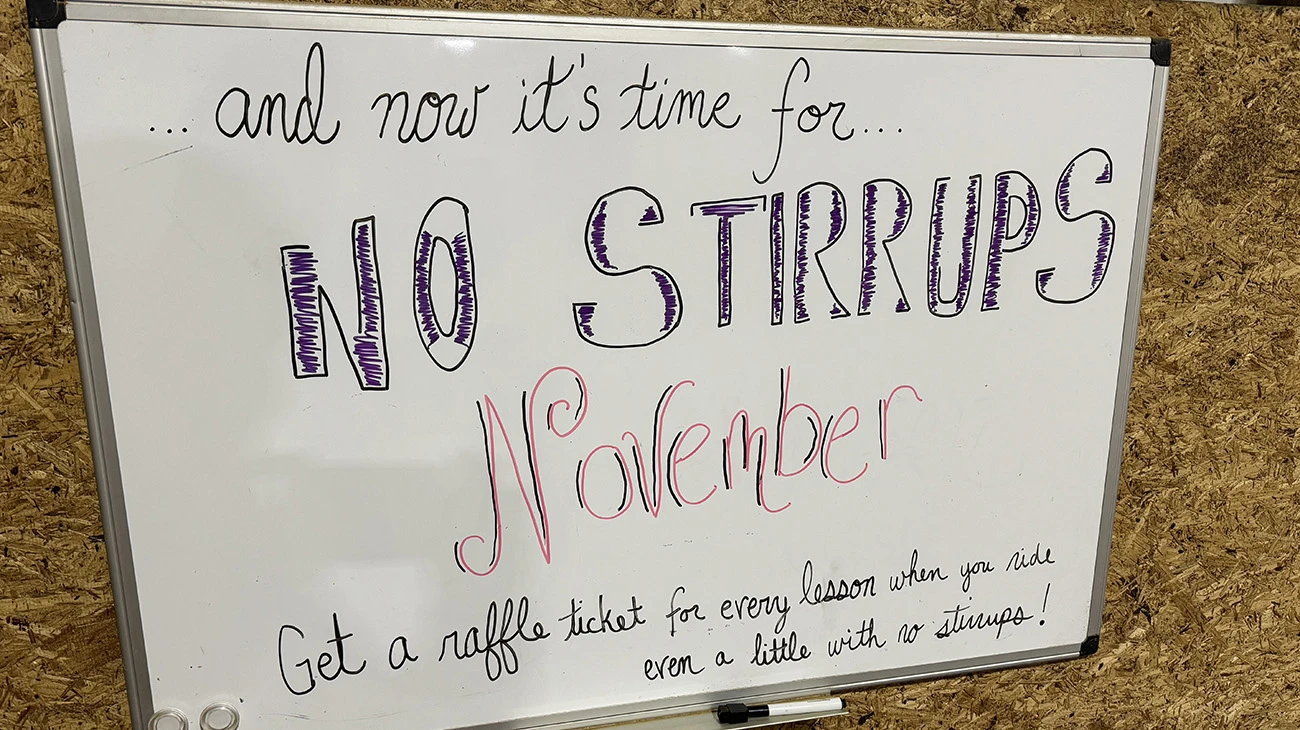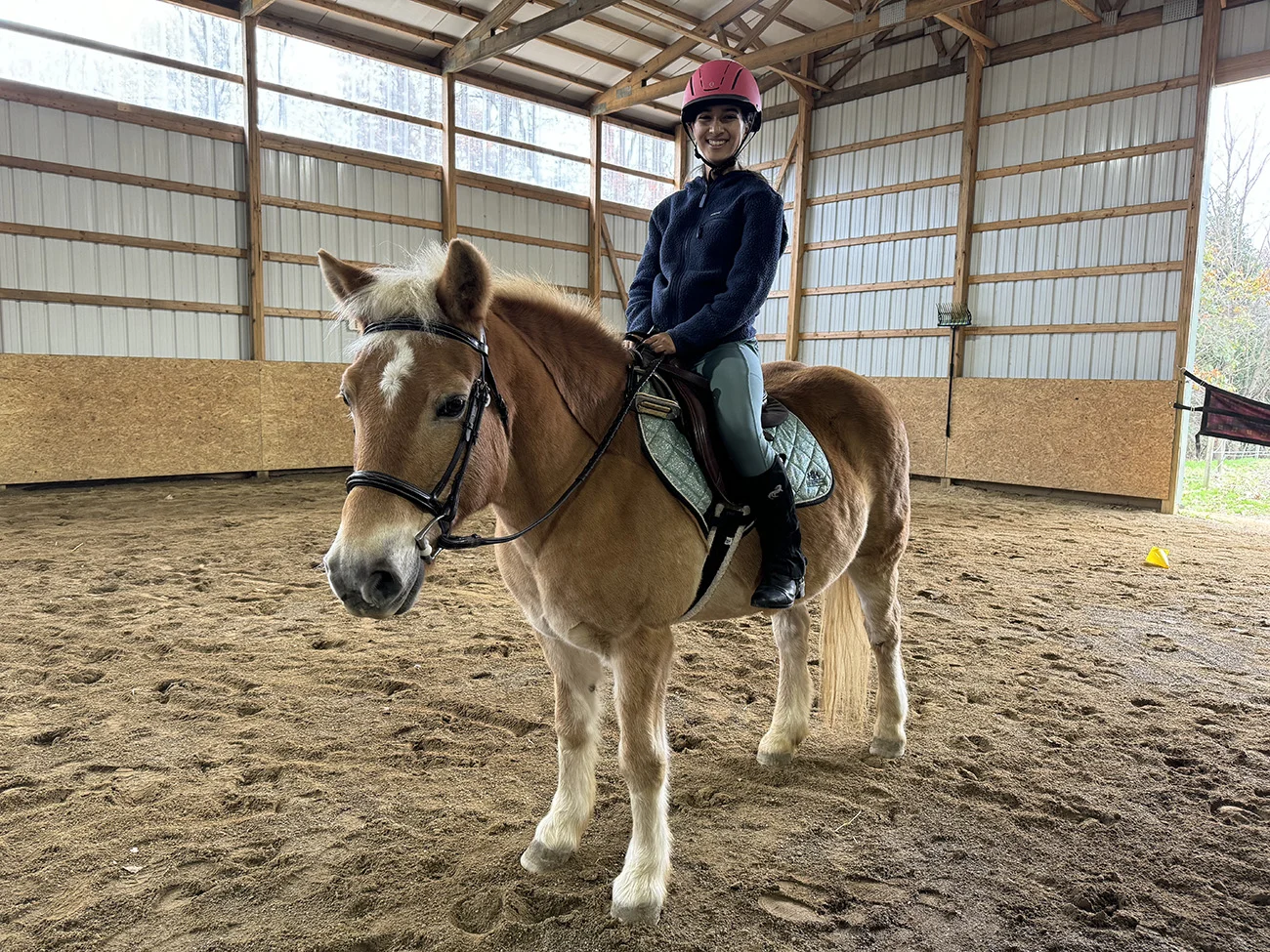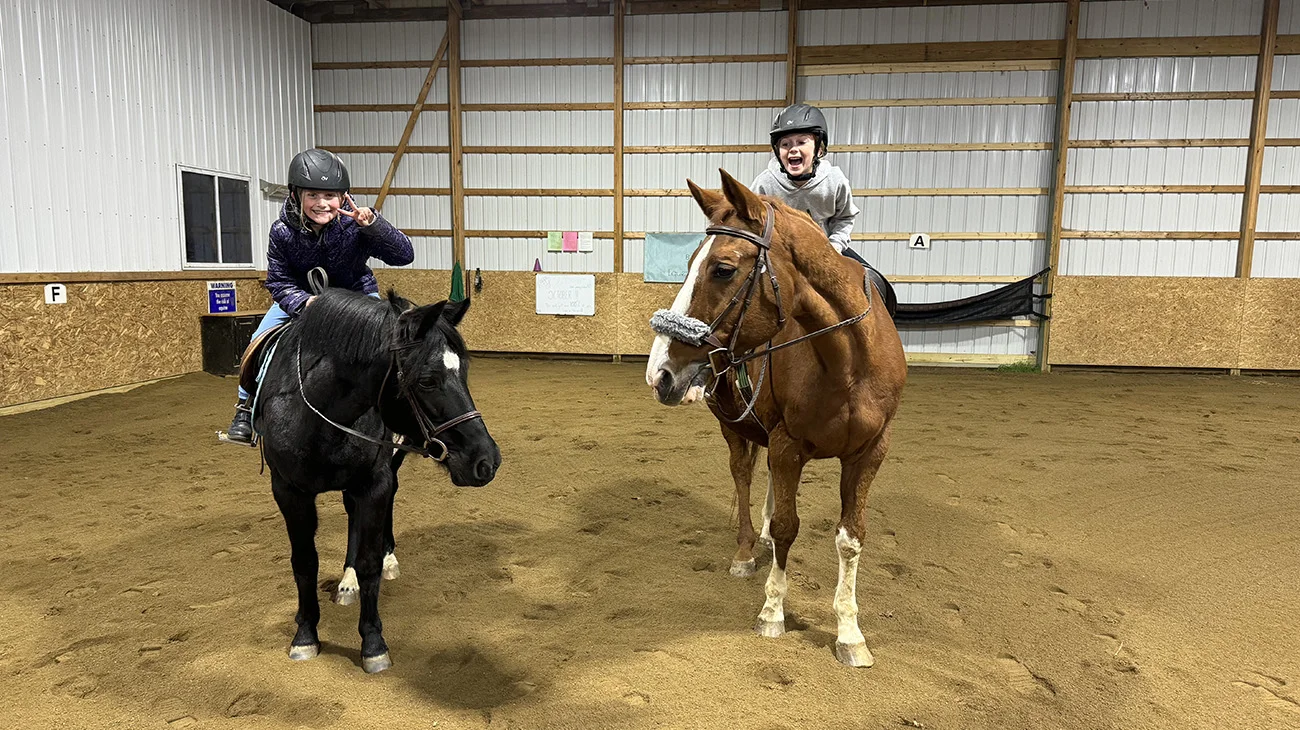In our lesson program, as the days get colder and temperatures drop, we use No-Stirrups November to celebrate and reward the hard work our students do year-round.
I’m seeing lots of chatter this year criticizing what has become an annual rite of passage in many places, a month of post-season, leg- and seat-building work commonly known as “No-Stirrups November.” Many of the posts I’ve seen come from people I greatly respect as experts in our field, who make excellent points about the ways No-Stirrups November can be problematic for both horses and riders.
In our lesson program, we actively participate in and even (gasp) celebrate NSN. But we do so with guiding philosophies in place that focus on year-round work on developing core and leg strength, and a vehement insistence that any stirrup-less work (in November, or otherwise) causes zero discomfort or stress to our lesson horses.

From our riders’ first lessons, we preach to our students that two parts of our horses are sacred: their mouths and their backs. If we violate either of these parts of our horse, we break down trust with our equine partners. Even the most forgiving horse, after repeated unintentional abuse, will retreat into defense mode to protect themselves from repeated jerks on the reins or thunks on the saddle.
We reinforce these concepts with our students, both on the ground and while mounted. In terms of protecting a horse’s mouth, we start talking about the concept as soon as we introduce a new student to a bridle. When teaching bridling, we stress the importance of asking the horse to take the bit, rather than jamming it against the horse’s teeth. When taking the bridle off, we stress the similar, though inverse, concept: Allow the horse to spit the bit out on their own, rather than jerking it out of their mouths by pulling the bridle down too fast or too roughly.
We talk about the sacredness of a horse’s back from the ground up, too, from a new rider’s first lesson. When saddling, we show our students how to gently lower the saddle into place and how to pull the saddle pad up into the gullet of the saddle in an effort to eliminate wither pressure. From the first time they step into a stirrup to mount, students learn to gently lower themselves down onto their horse’s back.
While students are mounted, we continue to reinforce and remind our students to protect these sacred parts of their horse, starting with skills as elemental as asking for a halt or steering around cones, through more advanced work.
But now it’s No-Stirrups November. And we have to make sure that these lessons don’t fall away like the autumnal leaves from the trees.
When I was a teenager and November 1st rolled around, our trainer pulled the stirrups and leathers from our saddles and hung them from nails above the tack room door, where they would collect dust until December.
No-Stirrups November was a rite of passage for so many of us growing up. But at the very least, it likely caused discomfort to our horses, and likely, at some moments, caused them more severe pain and stress. I remember stirrup-less lessons where what started off as a posting trot disintegrated to repeated collisions between my crotch the saddle to the rhythm of my horse’s trot. I’m so sorry, Grady and Elmo!
ADVERTISEMENT
Yes, by the end of November, my legs were stronger. I could hold a posting trot for laps around the arena after those weeks of practice, and I was proud of it.
But at what cost?
We certainly need to rethink No-Stirrups November to protect our horses.
But how do we continue to stress the importance of developing a strong, independent leg without hanging our stirrups in the tack room for a month?

First, at our farm our students do exercises to improve leg position and strengthen their legs and core all year long. Some kind of work without stirrups is a part of just about every lesson. New riders practice picking up their stirrups without using their hands, first at the halt and eventually at the walk. Intermediate riders regularly work without stirrups at the trot during lessons; demonstrating a posting trot without stirrups is a prerequisite, at our stable, to learning to canter.
Nothing I’m saying about year-round no stirrups work is profound, and I know that many strong programs across the country do the same. (I know many of you are nodding along or rolling your eyes, going “duh.”)
But here’s what we do, perhaps a little differently, that has been both beneficial and fun for our students in the fall. For us, No-Stirrups November simply becomes the month where we conscientiously reward our students for the work they’ve done year-round to improve their leg and seat.
We Start In October
When our lead instructor Meagan Greygor started teaching at our farm, she brought with her what she calls “Two-Point October.” (I’m fighting for “Off-the-Saddle October” because I’m an English teacher and I like alliteration; we’ll see what happens in 2024.) During October’s lessons, our students do extra work in their jumping position, spending about 25% of October’s first lesson in jumping position, then increasing to 50% and 75% over the course of a few weeks.
Each student’s last lesson in October is the “jumping position challenge,” where they go into jumping position after their warm up and hold it for as long as they can, meaning until they either sit on their own or until they can no longer hold the position correctly and are told by their instructor to sit. At any moment when the student’s positioning is painful or annoying for the horse (a swinging or gripping lower leg, or hands bracing on their horse’s neck, for example), the student is told to sit. The timer is stopped and their time is recorded.
At the end of October, we awarded prizes to the riders who held proper two-point position the longest.
ADVERTISEMENT
We considered breaking students into age groups or riding levels, but decided against it—and we realized we didn’t need to. Two elementary school students held jumping position for 38 minutes this year, beating out all of the barn’s older and more advanced riders! (Because our barn offers 45-minute private lessons, hour-long semi-privates, and 30-minute lessons for the littlest riders, we did award prizes for each type of lesson since they each ride for different amounts of time.)

All of our riders, no matter their age or riding level, were excited for the challenge and pushed themselves beyond their comfort zones—a win for everyone.
So, What About November?
Our stirrups stay on our saddles, thank you very much.
But we do put a greater focus on no-stirrup work during lessons, dependent on a rider’s age, riding ability, balance and strength. Some students’ goals for the month might be to see how fast they can pick up their stirrups without looking at them, maybe at the halt or the walk. More advanced students might work on improving their stirrup-less posting trot, or even canter transitions.
But unlike October, where the challenge is how long you can hold jumping position, we don’t ask the same during No-Stirrups November. Remember the sacred mouths and backs? There’s no way to protect them if you strip stirrups from saddles for a month, or challenge students to see how long they can posting-trot without them.
Instead, in November, we focus on the effort. For every lesson that a student participates in no-stirrup exercises, they are entered in a drawing for prizes. Each week in November, a few names are pulled and prizes are awarded. As the weather gets colder and the hours of daylight shrink, it’s a fun way to keep students excited and engaged in their riding, while protecting our MVPs, our lesson horses.
How do YOU do “No-Stirrups November”? What are other ways you challenge and engage YOUR riders at your farm throughout the year?
Sarah K. Susa is the owner of Black Dog Stables just north of Pittsburgh, where she resides with her husband and young son. She has a B.A. in English and Creative Writing from Allegheny College and an M.Ed. from The University of Pennsylvania. She teaches high school English full-time, teaches riding lessons and facilitates educational programs at Black Dog Stables, and has no idea what you mean by the concept of free time.














